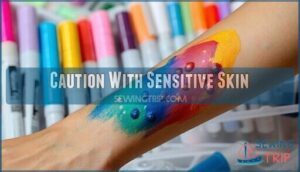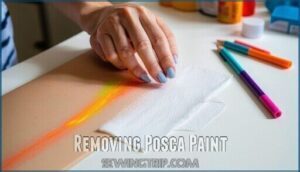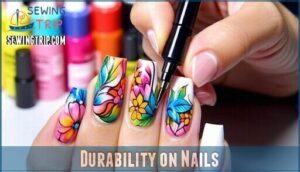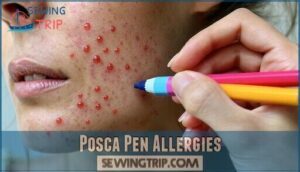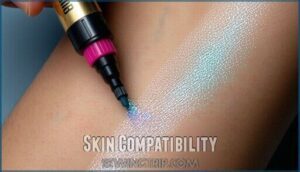This site is supported by our readers. We may earn a commission, at no cost to you, if you purchase through links.

Their acrylic paint content can cause irritation for sensitive skin or trigger allergic reactions in rare cases. It’s best to test a small area first, especially for kids or those with allergies.
Avoid using them near eyes, open wounds, or broken skin to prevent irritation or infection. While they’re fun for temporary body art, they’re not designed for prolonged contact.
Removing Posca paint is easy—just use soap, water, or a bit of olive oil. Curious about nail art possibilities? Keep reading!
Table Of Contents
Key Takeaways
- Test a small area first before using Posca pens on your skin to avoid irritation or allergic reactions.
- Don’t use Posca pens near your eyes, wounds, or broken skin to prevent risks of irritation or infection.
- Posca paint is temporary and washes off easily with soap, water, or olive oil.
- While non-toxic, Posca pens aren’t designed for long-term skin use or sensitive areas.
Posca Pen Ingredients
You might be curious about what’s inside a Posca pen that makes it so popular and versatile.
These markers use water-based acrylic paint, combined with binding agents, to create vibrant, long-lasting colors.
Water-Based Markers
Posca pens are water-based markers, making them a go-to for vibrant, skin-safe creativity.
Perfect for vibrant, skin-safe creativity, Posca pens deliver smooth, colorful results that inspire endless artistic possibilities.
Their pigment suspension guarantees smooth application, while water quality and binder types contribute to quick drying time and color stability.
These non-toxic skin markers are washable, offering a safer alternative for temporary designs.
Just remember, they’re not certified for prolonged skin use—wash off after fun, as they provide temporary designs.
Acrylic Paint Content
These markers pack a punch with their acrylic paint content, offering vibrant pigments that pop on any surface.
The high acrylic quality guarantees smooth application and quick drying time, so you’re not left waiting.
Unlike traditional paints, they’re water-based and free of harsh solvents, making them safe and versatile. Expect bold, permanent colors that truly last.
Binding Agents Used
Binding agents in water-based markers like Posca pens play a big role in holding pigment together.
These acrylic polymers guarantee smooth application and quick drying, keeping the paint vibrant and durable.
The water-based binders are ACMI certified, meaning they’re safe for most uses, though skin safety isn’t guaranteed.
Think of them as the glue that makes creativity stick!
Skin Safety Concerns
You might think Posca pens are harmless on skin, but there are a few things to watch out for.
From allergic reactions to irritation risks, it’s important to know how these markers interact with your body.
Potential Allergic Reactions
When using these pens, some people might notice redness, itching, or other signs of skin irritation.
This could point to pigment sensitivities or binding allergens in the ink.
Allergic reactions vary in severity—some appear immediately, while delayed reactions may surprise you later.
If you’re prone to skin sensitivity, consider alternative markers and always patch test before diving into your masterpiece.
Irritation and Infection Risks
Skin irritation or redness can occur with prolonged skin contact, especially if you’ve got sensitive skin or underlying conditions.
Open wound dangers and bacterial contamination are real risks, so avoid using Posca pens on compromised skin barriers.
If you notice itching or allergic reactions, wash the area immediately, and always prioritize clean, healthy skin before experimenting with these markers.
Eye and Wound Precautions
Accidentally got Posca paint near your eyes or an open wound? Don’t panic! Immediate rinse with water can help prevent eye irritation or infection.
Avoid using these markers on open wounds to guarantee skin safety. If redness or skin irritation persists, seek professional consultation.
Infection control starts with smart choices—keep Posca pens away from sensitive areas, and remember that immediate rinse with water is crucial in case of accidents.
Posca Pen Toxicity
You’ll be glad to know that Posca pens are non-toxic and certified safe for most artistic uses.
With no xylene or harmful solvents, they’re designed to keep your creativity worry-free.
Non-Toxic Certification
Posca pens are ACMI-certified and meet ASTM D4236 standards, guaranteeing they’re non-toxic and safe for artistic use.
While they’re not cosmetic-certified, their water-based formula avoids harmful chemicals.
These skin-safe markers are ideal for creative projects, but not for long-term skin use.
- ACMI Certification guarantees non-toxicity.
- ASTM Compliance ensures safety standards.
- Ingredient Transparency builds trust.
- Long-Term Effects are minimal when used correctly.
Absence of Xylene
Many markers once relied on xylene, a solvent known for health risks like skin irritation.
Thankfully, Posca pens are xylene-free, using alternative solvents like water for nontoxic, skin-safe markers.
This evolution in marker safety aligns with stricter solvent regulations, making them a top choice for creative, worry-free projects by ditching xylene, Posca guarantees vibrant colors without compromising skin safety.
Safe for Artistic Applications
Unlike markers with harsh chemicals, Posca pens shine with their ACMI Certification and ASTM Compliance.
Their odorless composition and solvent absence make them stand out as skin safe markers for artistic use.
While not cosmetic-certified, their pigment safety guarantees minimal skin irritation when used properly.
Always patch test first—better safe than sorry with non toxic skin markers, ensuring a safe experience with these skin safe markers!
Using Posca Pens on Skin
You might be tempted to use Posca pens for skin art, but it’s important to know they aren’t made for this purpose.
While they’re non-toxic, they can still cause irritation or allergic reactions, especially on sensitive skin.
Supervision for Children
When kids use skin-safe markers like Posca pens, supervision is key.
These non-toxic skin markers are great for creativity, but you’ll want to set clear boundaries.
- Make certain age-appropriate use; younger children might misuse them.
- Practice safe handling to avoid accidental marks near eyes or mouths.
- Provide parental guidance to minimize skin irritation and keep the fun safe.
Art material safety starts with you!
Caution With Sensitive Skin
If you’ve got sensitive skin, take extra care with Posca pens.
Allergic reactions like redness or itching can happen, so always patch test first.
A small dab on your arm can save you from unexpected skin irritation.
Not sure? Seek professional advice or explore product alternatives.
Remember, skin safety matters—better safe than sorry when trying something new on your skin! It’s about being safe.
Removing Posca Paint
Removing Posca paint from your skin is simple and doesn’t require harsh chemicals.
With soap, water, or even a bit of olive oil, you’ll have it cleaned up in no time.
Soap and Water Method
Removing Posca pen skin marks is simple with soap and water. Follow these steps for skin safety:
- Use lukewarm water for gentle exfoliation.
- Choose mild soap types to avoid skin reactions.
- Lather and scrub lightly, focusing on the marked area.
- For tougher stains, consider using a specialized pen remover.
- Rinse thoroughly to remove all residue.
- Pat dry with a soft towel, avoiding harsh drying methods, to ensure complete removal and gentle care.
Olive Oil Alternative
Why use olive oil for Posca paint removal? It’s a gentle, natural option that hydrates skin while lifting pigment.
Dab a small amount onto the ink, rub in circular motions, and wipe clean. It’s effective and safer for sensitive skin.
Olive oil can be found in various posca products.
Check out this comparison:
| Method | Oil Benefits | Skin Hydration |
|---|---|---|
| Olive Oil | Natural, gentle | Yes |
| Soap & Water | Quick, basic | No |
| Makeup Remover | Strong, effective | Minimal |
Makeup Remover and Baby Oil
A gentle removal method for Posca paint involves using makeup remover or baby oil. These effective ingredients are ideal for sensitive skin, ensuring safe application after skin contact.
Try these steps:
- Dab a cotton ball with makeup remover or baby oil.
- Gently rub the area.
- Rinse with warm water and soap.
- Repeat if needed for stubborn paint.
Nail Art With Posca Pens
You can use Posca pens for nail art, but they’re not as durable as specialized nail products. To keep your designs intact, always seal them with a clear topcoat.
Durability on Nails
Posca pens work for nail art, but their acrylic paint isn’t as durable as specialized products.
Proper nail preparation helps—clean, dry nails guarantee better adhesion.
Apply in thin layers with a steady application technique.
While waterproof, they chip faster without protection.
Product comparisons suggest using varnish or alternative sealants for longevity.
Topcoat frequency matters to maintain your design.
Sealing With Topcoat
To keep your nail art vibrant and chip-free, sealing with a clear topcoat is a must.
It boosts topcoat longevity and enhances finish effects, giving your designs a polished look.
Apply thin, even layers for better product compatibility and durability.
Layering methods matter—too thick, and it might peel.
Posca pens shine, but sealing guarantees lasting results.
Comparison to Specialized Nail Products
When comparing Posca pens to specialized nail products, their longevity and durability fall short.
While great for quick, creative nail art, they’re not designed for lasting wear.
Here’s why professional alternatives win:
- Longevity comparison: Nail products outlast Posca pens.
- Cost analysis: Specialized items save money long-term.
- Application differences: Posca pens lack precision.
- Design limitations: Limited durability under wear.
Posca Pen Allergies
If you’re thinking about using Posca pens on your skin, it’s smart to watch out for potential allergies.
Reactions like redness, itching, or swelling can happen, so a quick patch test can save you some trouble.
Symptoms of Allergic Reactions
Allergic reactions from skin contact with Posca pens can include redness, itching, swelling, or even hives.
Redness, itching, swelling, or hives—know the signs of allergic reactions before using Posca pens on your skin.
In some cases, blisters may develop, signaling a more severe response.
A patch test is your best bet for skin irritation prevention. Skin allergies vary, so testing a small area first helps avoid surprises.
Always rinse thoroughly if irritation occurs, and remember that a patch test can help prevent severe reactions.
Medical Advice and Treatment
If skin contact triggers allergic reactions, assess the reaction severity.
Mild redness or itching might fade, but swelling or prolonged irritation needs attention.
Consult a dermatologist for proper treatment and to prevent long-term effects like scarring.
Emergency treatment is rare but essential for severe cases.
Since Posca pens lack cosmetic certification, patch tests can help with skin irritation prevention.
Prevention and Precautions
A patch test is your first line of defense against allergic reactions.
Before skin use, apply a small amount, wait 24 hours, and check for irritation.
Since Posca pens aren’t certified for cosmetic use, explore alternative markers for safer options.
Follow skin precautions, avoid sensitive areas, and seek professional advice if unsure.
Immediate action prevents complications.
Skin Compatibility
You might wonder if Posca pens are truly safe for your skin, especially with their vibrant colors.
While they’re non-toxic, their suitability depends on factors like your skin’s sensitivity and the manufacturer’s guidelines.
Factors Affecting Skin Safety
Your skin type plays a big role in how it reacts to skin art markers.
Application duration matters too—leaving non-toxic skin markers on too long increases risks.
Underlying conditions like eczema can heighten sensitivity.
Product freshness is key; expired markers may irritate.
Environmental factors, like heat or humidity, can also impact results.
Always choose hypoallergenic markers for safer cosmetic use.
Individual Sensitivities
Reactions vary, so knowing your skin is key.
Sensitive populations or those with allergic predispositions should consider Skin Patch Testing before using Posca pens.
Long-term exposure might heighten risks, especially with chemical sensitivity.
To prevent skin reactions:
- Always patch test first.
- Limit contact time.
- Avoid broken skin.
- Wash off promptly if irritation occurs, which can help minimize skin reactions and ensure prompt treatment.
Manufacturer Recommendations
Manufacturers clearly state Posca pens aren’t certified for cosmetic use or skin application.
They recommend against using them on skin, especially over open wounds.
If you’re curious, a patch test is advised to check for allergic reactions.
For safety, follow the intended use, and seek professional advice if unsure.
Remember, Posca pens prioritize artistry, not body art.
Posca Pen Maintenance
Taking care of your Posca pens keeps them working smoothly and extends their life. Simple steps like cleaning the tips, replacing worn parts, and proper storage make all the difference.
Cleaning and Rehydrating Tips
Keeping your Posca pens in top shape is simple.
For tip cleaning, rinse under tap water or soak Non-Removable Tips briefly.
Struggling with dry markers? Tip Resaturation works wonders—just press the nib until paint flows again.
Consider Posca pen cleaning products for tougher stains.
Brush Marker maintenance is easy too: store horizontally for even paint flow.
Proper Storage Methods prevent drying, ensuring smooth creative sessions.
Replacing Removable Tips
When your Posca marker’s tip wears out, replacing tips is simple.
Many models offer removable tips, doubling their lifespan.
Check tip compatibility before purchasing replacements.
Alternative tips, like reversible ones, boost tip longevity.
For brush markers, replacing brush tips guarantees smooth application.
Proper marker maintenance, including tip cleaning and tip resaturation, keeps your pens ready for creative projects without skipping a beat, ensuring smooth application.
Storage and Handling
After swapping tips, proper marker storage keeps your Posca pens ready to go.
Always make certain cap closure is tight to maintain paint fluidity.
Horizontal storage helps balance the ink, avoiding clogs.
Watch out for temperature effects—extreme heat or cold can shorten shelf life.
Treat them like a good bottle of wine: stored right, they’ll last longer!
Creative Freedom
You can let your creativity shine with Posca pens, whether you’re sketching bold designs or blending vibrant colors.
These versatile markers offer the freedom to create both temporary and permanent art on various surfaces, but remember to use them cautiously on skin.
Versatile Artistic Applications
From wood to glass, Posca pens handle almost any surface, giving you endless possibilities for creativity.
They’re perfect for layering effects and blending techniques, whether you’re into mixed media or bold skin art.
While not certified as cosmetic markers, these non-toxic skin markers work well for temporary designs. Just remember, they’re better for surfaces than long-term body paint pens.
Mixing and Blending Colors
When creating art, Posca pens let you experiment with color layering and wet blending effortlessly.
Their acrylic-based paint consistency allows smooth color gradation, perfect for achieving unique surface effects.
Mixing colours directly on your canvas feels intuitive, like blending paints on a palette.
Whether you’re after soft shifts or bold contrasts, these markers make color blending surprisingly satisfying and easy.
Their ability to facilitate smooth color gradation makes them ideal for artists looking to create complex, layered artworks.
Permanent and Temporary Results
When working with skin drawing pens like Posca, results can be permanent or removable, depending on surface preparation and sealing techniques.
Material porosity plays a big role—on porous surfaces, the ink stays put, while non-porous ones allow easier removal.
Use a fixative option for durability or keep it simple for a temporary tattoo pen effect, considering removal difficulty beforehand, and always think about the surface preparation.
Frequently Asked Questions (FAQs)
How Can I Remove Posca Paint From My Skin?
Wash the paint off with soap and warm water, gently scrubbing with a washcloth.
For stubborn spots, try olive oil or makeup remover.
Act quickly to prevent staining, and avoid harsh chemicals on your skin.
How Long Will the Ink From Posca Pens Last on My Skin?
Funny enough, Posca ink on your skin can last a day or two, depending on how much you wash.
It’s water-based, so soap and water will fade it quickly—no need to panic!
Does POSCA pen come off skin?
Yes, Posca pen ink washes off skin easily with soap and water.
For stubborn spots, try a little olive oil or makeup remover.
Just don’t leave it on too long to avoid staining!
What pens are safe to draw on skin?
You can safely draw on skin using cosmetic-grade markers, body paint pens, or alcohol-based tattoo markers.
Avoid regular markers like Sharpies since they aren’t tested for skin use, and stick to skin-safe products for fun designs!
Is POSCA safe for children?
It’s ironic that something so colorful could spark concern.
Posca pens are safe for children, thanks to their non-toxic, water-based formula.
However, supervise use and avoid skin applications since they’re not designed for that, as this is a critical consideration for their intended use.
How can I remove Posca paint from my skin?
To remove Posca paint from your skin, wash with soap and warm water immediately.
For stubborn spots, try olive oil or baby oil and gently rub.
Avoid harsh scrubbing; it’s not a wrestling match!
How long will the ink from Posca pens last on my skin?
Don’t worry—it’s not permanent.
Posca ink tends to last a day or two on skin, fading with washing.
If you’re active or scrub lightly with soap, it’ll disappear faster.
Nothing to sweat about!
Are Posca pens suitable for use on sensitive skin?
Posca pens aren’t ideal for sensitive skin.
While they’re non-toxic and water-based, pigments or binders could irritate.
Always test a small area first, and don’t use them on cuts or around eyes.
Can Posca pens be used for body art?
Using Posca pens for body art is like painting on a canvas that moves.
While they’re non-toxic, they’re not meant for skin.
Always patch test first, as the pigments could irritate sensitive skin.
How long does Posca paint last on skin?
The paint usually lasts a day or two on skin, depending on sweat, friction, and washing.
It’s not permanent and rubs off faster with soap and water, making it fun but temporary for body art.
Conclusion
Think of Posca pens as a fun tool with boundaries—they’re great for temporary body art but not long-term skin use.
These water-based markers are generally safe, thanks to their non-toxic formula, but their acrylic paint can irritate sensitive skin.
Always test a small area first, and avoid using them near eyes or wounds. If the paint sticks, soap or olive oil will do the trick.
Enjoy exploring your creativity while keeping safety in mind!
- https://www.tiktok.com/@citriina/video/7054261917921086766
- https://poscart.com.au/blog/how-to-create-skin-tones-and-colours-effectively-with-posca-markers/?srsltid=AfmBOoqmR-TM-OgHKEy43cGGWRu1Hn0AJp-xaQTzNM8tF6W83MOACLgd
- https://poscausa.com/faq/
- https://www.reddit.com/r/UnconventionalMakeup/comments/4nsuci/posca_markers_me/
- https://www.beesource.com/answers/are-posca-markers-toxic-on-skin/




